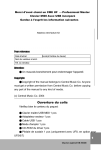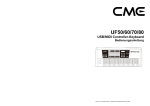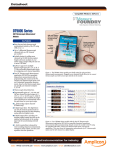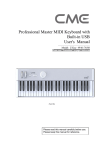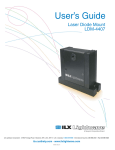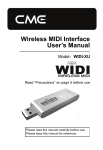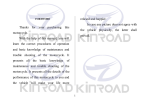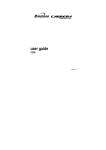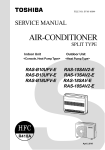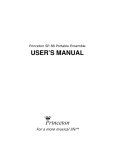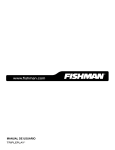Download CME UF7 User`s manual
Transcript
Thank you for choosing CME UF Professional Master MIDI Keyboard with Built-in USB Please keep all the important information here Attach your invoice or receipt here ○ ○ ○ ○ ○ ○ ○ ○ ○ ○ ○ ○ ○ ○ ○ ○ ○ ○ ○ ○ ○ ○ ○ ○ ○ ○ ○ ○ ○ ○ ○ ○ ○ ○ ○ ○ ○ ○ for reference Purchase date Dealer's name and addr. Serial(on the back of the keyboard) Dealer's tel. Warning: Improper connection may cause damage to the device. Copyright: Copyright of the manual belongs to Central Music Co. Anyone must get a written permission from Central Music Co. before copying any part of the manual to any kind of media. (c) Central Music Co. 2004 Open the package Please check all the items in your UF keyboard package: USB MIDI Master keyboard 1 pcs AC adapter 1 pcs USB cable 1 pcs User's manual 1 pcs CD-ROM for device driver 1pcs Sustain pedal 1 pcs (included with UF8 ONLY, optional for UF5/6/7) USB MIDI Master Keyboard 1 PRECAUTIONS IMPORTANT Always follow the basic precautions listed below to avoid the possibility of serious injury or even death from electrical shock, damages, fire or other hazards. These precautions include, but are not limited to, the follows: 1. Read and understand all the instructions. 2. Always follow the instructions on the instrument. 3.Before cleaning the instrument, always remove the electric plug from the outlet as well as the USB cable. When cleaning, use a soft, dry cloth. Do not use gasoline, alcohol, acetone, turps or any other organic solution; do not use liquid cleaner or spray cleaner, or too wet cloth. 4. Do not use the instrument near water or moisture, such as bathtub, washbasin, or washing poor in the kitchen, or similar places. 5. Do not place the instrument in an unstable position where it might accidentally fall over. 6. Do not jam sinks or holes of the instrument; those sinks of holes are used for air circulation to prevent the instrument from overheating. Do not place the instrument near heat sink or any places with poor air circulation. 7. Always use the AC adaptor included with the instrument; do not use any other AC adaptor. 8. Do not place anything on the power cord. Make sure the power cord is set on a safe place, so nobody will step on it and no body will get trip over by it. 9. Do not overload the outlet and AC cable to avoid fire or electrical shock. 10. Do not insert anything in the instrument, which may cause fire or electrical shock. Do not splash any kind of liquid to the instrument. 11. Do not disassemble the instrument in case of accidental electrical shock. 12. Always take the instrument to qualified service center in need of repair. You will cause yourself in danger if you open or remove the cover, and improper assembly may cause electrical shock in the future use. 13. Unplug all the connectors and take the instrument to qualified service center if anything in the below list happens: A. The power cord or connector get hurt or worn out. B. Any liquid get in the instrument. C. The instrument gets rain or water splash. D. The instrument dose not work properly after following all the instructions regarding to troubleshooting. E. The instrument falls down or gets broken. F. The instrument functions poorly. 14. Do not use the instrument when thundering; otherwise the thundering may cause long-distance electrical shock. 2 15. Do not use the instrument when there is gas leak nearby. USB MIDI Master Keyboard Keep this manual in safe place CAUTION: Setting up Do not connect the instrument when thundering. Do not set up the cord or outlet to moisture place, except for that the outlet is specially designed for moisture. When the power cord is connected to the AC outlet, do not touch the naked part of cord or connector. Always follow the instructions carefully when setting up the instrument. WARING: Do not expose the instrument to rain or moisture, to avoid fire or electrical shock. Other precautions: Keep the instrument away from electrical interface source, such as fluorescent light and electrical motor. Keep the instrument away from dust, hear and vibration. Do not expose the instrument to sun light. Do not place heavy object on the instrument; do not place containers with liquid on the instrument. Do not touch connectors with wet hand Central Music Co. is not responsible for any damage or data loss caused by improper operation to the instrument. All the pictures and LCD display in the manual are used for demonstration; they may be different from a real instrument. Features Professional Master MIDI Keyboard with Built-in USB 49/61/76 keys with Initial Touch/Aftertouch(UF5/6/7) 88keys Hammer Effect with Initial Touch/Aftertouch(UF8) Pitch wheel and Modulation wheel 8 assignable knobs, preset function includes Cutoff / Resonance / Attack / Release / Pan / Reverb / Chorus / Tempo 9 assignable faders(sliders), preset function includes channel volume(chn1chn16) and Master volume, Drawbar organ LED display 9 control buttons for Program change, Transpose, Octave, Channel, Split, Dual and others. 6 Sequencer remote control buttons: REC, PLAY, STOP, FF, REW, BACKWARD BC(Breath Controller) port 1 MIDI out port Sustain pedal and Volume pedal connector USB MIDI port, power can be supplied with USB USB Drivers for Win2000/XP and Mac OSX USB MIDI Compatible with major sequencer and audio software Optional Firewire expansion board for IEEE 1394 audio interface USB MIDI Master Keyboard 3 Contents Contents 1.Connection ............................................................ 5 1.1 Front panel ................................................................................. 5 1.2 Rear panel ................................................................................. 6 1.3 Connect UF to tone generators ................................................. 7 1.4 Add UF to computer music system ........................................... 8 1.5 Driver installation ....................................................................... 9 2.Play the instrument ............................................... 9 2.1 Turn on the instrument .............................................................. 9 2.2 Play the demo song ................................................................... 9 2.3 Reset .......................................................................................... 9 2.4 Value adjustment and display ................................................. 10 2.5 Select voice .............................................................................. 10 2.6 Pitch bend wheel ..................................................................... 10 2.7 Modulation wheel ..................................................................... 10 2.8 Adjust volume and customize faders ..................................... 10 2.9 Transpose ................................................................................ 11 2.10 Octave shift ............................................................................. 11 2.11 All notes off ............................................................................. 13 3.Advanced functions ............................................. 13 3.1 Change MIDI channel .............................................................. 13 3.2 Edit voice and customize knobs .............................................. 13 3.3 Send initializing sysx ................................................................ 14 3.4 Adjust velocity curve ................................................................. 15 3.5 Split .......................................................................................... 15 3.6 Dual .......................................................................................... 16 3.7 After touch ................................................................................. 17 3.8 Drawbar organ ......................................................................... 17 4.Computer music system connection .................. 17 4.1 Sequencer remote control ....................................................... 17 4.2 Select MIDI route ...................................................................... 18 5.Appendix ............................................................. 18 4 5.1 Controller parameters list ........................................................ 18 5.2 Troubleshooting ....................................................................... 20 5.3 Specifications .......................................................................... 21 5.4 MIDI implementation chart ....................................................... 22 5.5 Index ......................................................................................... 23 USB MIDI Master Keyboard Connection 1.Connection 1.1 Front Panel Sequencer remote control Those buttons are used to control external sequencer. Voice editing knobs 8 assignable knobs with preset for voice editing. Volume Faders 8 assignable faders (sliders) with preset for channel volume. Master Volume Master volume fader for external tone generator (GM standard.) Knob Func This button is used to switch knob function. Fader Func This button is used to switch fader function. LED display The LED displays related information of the keyboard. Function buttons Those buttons are used to make a lot of functions of the keyboard. Data dial Data dial is used to adjust current value. Inc/Dec Button Increase or decrease current value by one when pushed. 5 USB MIDI Master Keyboard Connection 6 1.2 Rear panel MIDI OUT All the MIDI messages from the UF keyboard or from USB transmission will be outputted to external MIDI devices via MIDI OUT terminal. SUSTAIN PEDAL A sustain pedal can be connected to SUSTAIN PEDAL terminal. The sustain pedal will generate MIDI controller #64 message. CONTROLLER PEDAL A controller pedal can be connected to CONTROLLER PEDAL terminal. The controller pedal will generate MIDI controller message, the controller # is assignable To assign a controller # for the pedal, press DRAWBAR and A. TOUCH at the same time, then the current controller # (11) will be displayed on the LED, now we can use DEC/INC button or the data dial to change the controller # to any number from 0 to 127. B.C.(Breath Control) A breath controller (such as YAMAHA BC3) can be connected to B.C. jack. The breath controller will generate MIDI controller #2 (assignable) message. To assign a controller # for the B.C.jack, press PROGRAM and OCTAVE at the same time, then the current controller # (02) will be displayed on the LED, now we can use DEC/INC button or the data dial to change the controller # to any number from 0 to 127. Note: The B.C. jack only works when the keyboard is powered by AC. Adapter. USB USB port is used to connect the UF keyboard to computer by an USB MIDI Master Keyboard Connection USB cable for bi-direction data transmission. CABLE HOOK Keep the power cord in the CALBE HOOK when necessary for good power connection. POWER INLET Power supply goes from the A.C. adapter to the POWER INLET. POWER SWITCH POWER SWITCH is used to turn on or turn off the UF keyboard. 1.3 Connect UF to tone generators Warning: Turn off all the devices before connection Connect UF to a tone generate then you can play 1.3.1 Connect UF MIDI OUT to tone generator MIDI IN via MIDI cable 1.3.2 Connect tone generator to speaker system, or use headphone instead 1.3.3 Switch tone generator HOST SELECT to "MIDI" if there is a HOST SELECT in the tone generator 1.3.4 Plug AC adaptor's output connector to UF DC IN 1.3.5 Please refer to the figure for connections with Sustain pedal USB MIDI Master Keyboard 7 Connection (included with UF8), Controller pedal, or Breath Controller(such as YAMAHA BC3). 1.3.6 Now you can play the tone generator with UF keyboard. 1.4 Add UF to computer music system You can add UF keyboard to the computer music system, then you can use UF as the master MIDI keyboard of the system to play music as well as input other MIDI messages. 8 1.4.1 Connect UF USB port to your computer USB port via the USB cable supplied with the UF keyboard. 1.4.2 Install USB driver in the computer(See chapter 1.5) 1.4.3 Install then start your MIDI sequencer software and soft synthesizer (such as SampleTank). 1.4.4 Connect your audio out to the stereo system. USB MIDI Master Keyboard 1.5 Driver installation 1.5.1 Connect UF to computer via USB cable 1.5.2 Power on the computer 1.5.3 Insert UF CD-ROM to computer 1.5.4 Follow instructions in the README file to finish the installation. Play the instrument Hint: You can also use MIDI cable to connect UF keyboard to computer music system via a MIDI interface, in this way you do not have to make USB connection, nor to install USB driver. Hint: When using USB cable to connect UF keyboard to computer music system, you must install the UF driver to the computer; otherwise the system will not accept the device. 2. Play the instrument 2.1 Turn on the instrument You can find the Power switch in the rear panel. Make sure all the devices are properly connected before turn on the keyboard. 2.2 Play the demo song (DEMO) There is one demo song in the UF keyboard. You can play the demo song according to below steps: 2.2.1 Turn on UF keyboard, tone generator, and speaker system 2.2.2 Set proper volume for speaker system to avoid damage to your ear 2.2.3 Push V.CURVE and A.TOUCH on UF front panel at the same time to play the demo song. Push the two buttons again to stop. 2.3 Reset By using "Reset" function, you can restore the UF keyboard to its factory default settings. (Without "Reset", the keyboard always memorize its recent settings.) 2.3.1 Push SPLIT and DUAL" on UF front panel at the same time and keep the buttons hold down for at least two seconds to actiUSB MIDI Master Keyboard 9 Play the instrument vate reset function. 2.3.2 During the reset process, the LCD flashes until reset process is finished. Hint: Reset function will clear all of your settings to the keyboard! 2.4 Value adjustment and display 2.4.1 Data dial Please notice that for current selected function, the value will be displayed on LCD. When you rotate the Data dial, current value will be changed accordingly, and the LCD will display the new value. 2.4.2 DEC / INC button Please notice that for current selected function, the value will be displayed on LCD. When you push DEC/INC button, current value will be changed accordingly, and the LCD will display the new value. Hint: 1.If you push and hold down the button for 0.5 second, the value will repeatedly decrease or increase. 2.If you push DEC and INC at the same time, current value will return to factory default. 2.4.3 LCD The LCD displays all the related information of the keyboard. 2.5 Select voice (PROGRAM) This button is used to change the voice of current channel. 2.5.1 After you push this button, LCD will display current voice number, then you can use Data dial or DEC/INC button to change the voice number. The new voice number will be displayed on the LCD. Hints: 1.Voice number range is 0-127. 2. 10 USB MIDI Master Keyboard By rotating the pitch bend wheel when playing the keyboard, you can change the current note pitch. 2.6.1 Pitch bend wheel sends PITCH BEND message. 2.7 Modulation wheel By rotating the Modulation wheel when playing the keyboard, you can add vibration to the sound. 2.7.1 Modulation wheel sends MIDI controller 1# message. Play the instrument 2.6 Pitch bend wheel 2.8 Adjust volume and customize faders You can use front panel faders to control volumes for each channel (to send MIDI controller 7# message to the channel). Before you adjust the volume, please notice the LED indicator for FADER FUNC. button: This button will set the 9 faders to one of the three function sets below: 1 When no LED indicator lights, the 9 faders are used to control master volume and channel volume for channel 1 to channel 8. 2 When the upper LED indicator lights, the 9 faders are used to control master volume and channel volume for channel 9 to channel 16. 3 When the lower LED indicator lights, the 9 faders are used as assignable fader controllers (CS0-CS8). Hints: 1.Make sure your tone generator meets or compatible with General MIDI specification 1.0, otherwise those faders do not work. 2. Some music software does not fully support the sysx for master volume, so please be careful using this function. Assign functions to faders: 1 Push and hold FADER FUNC. button, then move one of the faders that you wish assign function to, after that you can assign new controller number to the fader. 2 After new controller number is assigned, release FADER FUNC. button. Hint For detail about assignable controllers, refer to appendix 5.1 USB MIDI Master Keyboard 11 Play the instrument When no LED lights for “FADER FUNC.” button, faders function list: Function Channel Controller# Default Value range M.Vol ALL M.volume 127 0-127 Vol.1 1 7 100 0-127 Vol.2 2 7 100 0-127 Vol.3 3 7 100 0-127 Vol.4 4 7 100 0-127 Vol.5 5 7 100 0-127 Vol.6 6 7 100 0-127 Vol.7 7 7 100 0-127 Vol.8 8 7 100 0-127 When upper LED lights for “FADER FUNC.” button, faders function list: Function Channel Controller# Default Value range M.Vol ALL M.volume 127 0-127 Vol.9 9 7 100 0-127 Vol.10 10 7 100 0-127 Vol.11 11 7 100 0-127 Vol.12 12 7 100 0-127 Vol.13 13 7 100 0-127 Vol.14 14 7 100 0-127 Vol.15 15 7 100 0-127 Vol.16 16 7 100 0-127 When lower LED lights for “FADER FUNC.” button, faders function list: (You can assign each faders to different controller #) Function Channel Controller# Default Value range CS0 11 127 0-127 CS1 11 127 0-127 CS2 11 127 0-127 CS3 11 127 0-127 CS4 11 127 0-127 CS5 CS6 11 11 127 127 0-127 0-127 CS7 11 127 0-127 CS8 11 127 0-127 2.9 Transpose (TRANSPOSE) By using the transpose function, you can transpose the keyboard by semitones. 2.9.1 Push TRANSPOSE button, then you can use Data dial or DEC/INC button to change the transpose value. 2.9.2 The default value for transpose is 00, and the value range is 12 12(One octave up or down). 2.10 Octave shift (OCTAVE) 12 By using the octave shift function, you can transpose the keyboard by octaves. 2.10.1 Push OCTAVE button, then you can use Data dial or DEC/ INC button to change the octave value. 2.10.2 The default value for octave is 00, and the value range is -3 3(three octaves up or down). Hint: If the shifted note exceeds MIDI key range, the exceeded note will not USB MIDI Master Keyboard 2.11 All notes off (ALL NOTES OFF) If the external tone generator produces weird voice(such as continuous long voice), you can push TRANSPOSE and OCTAVE at the same time to send controller 123# to stop all the notes of the tone generator. Hint: If the tone generator does not support controller 123#, or the weird voice is caused by other reasons, this function may not work. Advanced functions make sound. 3. Advanced functions 3.1 Change MIDI channel (CHANNEL) Push CHANNEL button, then you can use Data dial or DEC/INC button to change the MIDI channel value to send MIDI messages. 3.1.1 The default value for MIDI channel is 01, and the value range is 01 16 3.2 Edit voice and customize knobs (KNOB FUNC.) You can use front panel knobs to adjust the sound parameters for current channel. Before you adjust the volume, please notice the LED indicator for KNOB FUNC. button: This button will set the 8 knobs to one of the two function sets below: 1 hen the LED indicator does not light, the 8 knobs are used to control 8 upper functions (default). 2 When the LED indicator lights, the 8 knobs are used to control 8 lower functions. Hint: Make sure your tone generator meets or compatible with General MIDI specification 1.0, otherwise those faders do not work. Assign functions to knobs: 1 Push and hold KNOB FUNC. button, then rotate one of the knobs that you wish assign function to, after that you can assign new controller number to the knob. USB MIDI Master Keyboard 13 Advanced functions 2 After new controller number is assigned, release FUNC. button. KNOB Hint For detail about assignable controllers, refer to appendix 5.1 When the LED indicator for “KNOB FUNC.” does not light, knobs function list: Knob Func Controller# Default Value range CUTOFF 74 64 0-127 RESONANCE 71 64 0-127 ATTACK 73 64 0-127 RELEASE 72 64 0-127 PAN 10 64 0-127 REVERB 91 40 0-127 CHORUS TEMPO 93 0 120 0-127 20-250 Hints: 1.If your external device does not support TEMPO message or is not set up properly, the TEMPO knob will not work. 2.The TEMPO range is 20-250. When the LED indicator for “KNOB FUNC.” lights, knobs function list (You can assign each knobs to different controller #): Knob Name Knob Func Controller# Default Value range KN1 Expression 11 127 0-127 KN2 Breath 2 127 KN3 BANK MSB 0 0 0-127 KN4 BANK LSB 32 0 0-127 KN5, KN6, KN7, KN8 Expression 11 127 0-127 0-127 3.3 Send initializing sysx 14 3.3.1Send GM on message (GM ON) Push DRAWBAR and V.CURVE at the same time, the keyboard will send sysx for GM on (F0 7E 7F 09 01 F7). By sending GM on message, you can make GM initializing for General MIDI compatible tone generators. 3.3.2 Send XG on message (XG ON) Push PROGRAM and TRANSPOSE at the same time, the keyboard will send sysx for XG on (F0 43 10 4C 00 00 7E 00 F7). By sending XG on message, you can make XG initializing for XG compatible tone generators. 3.3.3 Send GS on message (GS ON) USB MIDI Master Keyboard Hint: Some music software may have problem with sysx, so please be careful using this function. Advanced functions Push CHANNEL and SPLIT at the same time, the keyboard will send sysx for GS on (F0 41 10 42 12 40 00 7F 00 41 F7). By sending GS on message, you can make GS initializing for GS compatible tone generators. 3.4 Adjust velocity curve (V.CURVE) V.CURVE button is used to adjust velocity response of the keyboard. You can choose from four preset velocity curves. 1 The default velocity curve is normal(NORM) with LCD display 0 and the V.CURVE LED dose not light. 2 Push V.CURVE once, the LCD displays 1 showing the keyboard velocity curve changes to 1(HARD) and the V.CURVE LED lights. 3 Push V.CURVE twice, the LCD displays 2 showing the keyboard velocity curve changes to 2(SOFT),and the V.CURVE LED lights. 4 Push V.CURVE third times, the LCD displays 3 showing the keyboard velocity curve changes to 3(WIDE),and the V.CURVE LED lights. 5 Push V.CURVE four times, the LCD displays 0 showing the keyboard velocity curve changes back to default, and the V.CURVE LED does not light. 3.5 Split (SPLIT) By using the split function, you can split the UF keyboard to right section and left section, each section has its own channel and voice settings. USB MIDI Master Keyboard 15 Advanced functions 3.5.1 First you should set up voice and channel for the left section. 3.5.2 Push SPLIT button to activate split function, and the keyboard is split to two sections at key #F2(54), which is called the split point. 3.5.3 You can only adjust the voice and channel settings for the right section when split function is on. 3.5.4 To change the split point: push and hold SPLIT button, then press a key in the keyboard to indicate a new split point, the key number will be displayed on the LCD. Release SPLIT button when finished. Hints: 1.When playing the keyboard, Pitch bend wheel, Modulation wheel, Sustain pedal, Controller pedal, Breath Control, etc... will work for both left and right section at the same time. 2.You cannot assign the left and right section to the same MIDI channel. When you turn on the split function, the keyboard will assign the next channel for the right section than the left section. However, you can change the MIDI channel after turning on the split function. 3. When SPLIT function is turned on, DUAL function will be automatically turned off. You cannot turn on DUAL function when SPLIT function is on. 3.6 Dual (DUAL) By using the dual function, you can select and play two different voices simultaneously. 3.6.1 Select and set the first voice. 3.6.2 Turn on the dual function by pushing DUAL button, then select and set the second voice. When you play the keyboard in dual mode, your performance message will be sent to two MIDI channels simultaneously. (The default MIDI channels for dual are channel 1 and 2). 16 Hints: 1.When playing the keyboard, Pitch bend wheel, Modulation wheel, Sustain pedal, Controller pedal, Breath Control, etc... will work for both the first and second voice at the same time. 2.You cannot assign the first and second voice to the same MIDI channel. When you turn on the dual function, the keyboard will assign the next chanUSB MIDI Master Keyboard 3.7 After touch (A.TOUCH) A.TOUCH is the switch for the channel after touch function. 3.7.1 By pushing A.TOUCH button, you can turn on or off the after touch function of the keyboard, to allow or permit the after touch message from the keyboard. Note: This function only works when the keyboard is powered by the AC. Adapter. 3.8 Drawbar organ (DRAWBAR) With the drawbar organ function, you can use fader CS0-CS8 as drawbars to adjust organ voice. 3.8.1 When DRAWBAR function is on, fader CS0-CS8 work as below: Fader func Channel Organ bar Controller# Default Value range CS0 Current 16' 12 64 127-0 CS1 Current 5 1/3' 13 64 127-0 CS2 Current 8' 14 64 127-0 CS3 Current 4' 15 64 127-0 CS4 Current 2 2/3' 16 64 127-0 CS5 Current 2' 17 64 127-0 CS6 Current 1 3/5' 18 64 127-0 CS7 Current 1 1/3' 19 64 127-0 Computer music system connection nel for the second voice than the first voice. However, you can change the MIDI channel after turning on the dual function. 3. When SPLIT function is turned on, DUAL function will be automatically turned off. You cannot turn on DUAL function when SPLIT function is on. CS8 Current 1' 20 64 127-0 Hint: If you tone generator does not support drawbar organ mode, the drawbar function of the keyboard will not work. 4. Computer music system connection 4.1 Sequencer remote control There are 6 sequencer control buttons. When the UF keyboard is connected to a computer, you can use those buttons to send MIDI sync commands, to control PLAY, REC, F.F., REW etc... in the music software. 4.1.1 The 6 buttons are: Top Rewind Forward Record Stop Play. Hints: 1.Those functions need software support, and you must make the right setup in the software before you can use those buttons properly. USB MIDI Master Keyboard 17 Appendix 2.If you press one of the 6 buttons after the keyboard is powered on, the keyboard will start sending MTC(MIDI timing clock). To stop sending MTC, press "Reset" compound, or just turn off then turn on the keyboard. 4.2 Select MIDI route Press “CHANNEL” and “DUAL” at the same time, the current MIDI route status (code) will be displayed on the LED, then we can use DEC/INC button or the data dial to select the MIDI route by its status code. Status 0 1 KB to USB on on KB to MIDI out on off KB to firewire on off USB to MIDI out USB to firewire off off on on 5. Appendix 5.1 Controller parameters list 18 Controller# 0 1 2 3 4 5 6 7 8 9 10 11 12 13 14-31 32 33 34 35 36 37 Function Bank Select MSB Modulation MSB Breath MSB Controller Foot Controller MSB Portamento time MSB Data Entry MSB Channel Volume MSB Balance MSB Controller Panpot MSB Expression MSB Effect Control MSB Effect Control MSB Controller Bank Select LSB Modulation LSB Breath Control LSB Controller Foot Control LSB Porta Time LSB USB MIDI Master Keyboard Default 0 0 127 0 127 0 2 100 64 0 64 127 0 0 0 0 0 127 0 127 0 Value range 0-127 0-127 0-127 0-127 0-127 0-127 0-127 0-127 0-127 0-127 0-127 0-127 0-127 0-127 0-127 0-127 0-127 0-127 0-127 0-127 0-127 Data Entry LSB Channel Volume LSB Balance LSB Controller Pan LSB Expression LSB Controller Sustain Portamento Sostenuto Soft Pedal Legato FootSwitch Hold 2 Sound Controller Resonance Release Time Attack Time Cutoff Decay Time Vibrato Rate Vibrato Depth Vibrato Delay Sound Controller Controller Portamento Control Controller Reverb Effects Chorus Effects Effects RPN Increment RPN Decrement NRPN LSB NRPN MSB RPN LSB RPN MSB Controller All Sound Off Reset All Controllers Local Controllesr All Notes Off OMNI Off OMNI On Mono Poly 0 127 64 0 64 127 0 0 0 0 0 0 0 64 64 64 64 64 0 64 64 64 64 0 0 0 40 0 0 0 0 0 0 0 0 0 0 0 0 0 0 0 0 0 0 0 0-127 0-127 0-127 0-127 0-127 0-127 0-127 0-127 0-127 0-127 0-127 0-127 0-127 0-127 0-127 0-127 0-127 0-127 0-127 0-127 0-127 0-127 0-127 0-127 0-127 0-127 0-127 0-127 0-127 0-127 0-127 0-127 0-127 0-127 0-127 0-127 0-127 0-127 0-127 0-127 0-127 0-127 0-127 0-127 0-127 0-127 USB MIDI Master Keyboard Appendix 38 39 40 41 42 43 44-63 64 65 66 67 68 69 70 71 72 73 74 75 76 77 78 79 80-83 84 85-90 91 92 93 94 95 96 97 98 99 100 101 102-119 120 121 122 123 124 125 126 127 19 Appendix 5.2 Troubleshooting Trouble After turning on the power switch, the keyboard is not powered on Possible reasons and action to solve 1. Make sure you have connect the keyboard to its AC adaptor with proper AC supply 2. If the power is supplied via host USB, please check the USB connection, and make sure that the host computer is turned on. No sound when playing the 1. There is no tone generator in the UF keyboard. UF keyboard To make sound, you can connect the UF keyboard to an external tone generator, or you can also use optional Fireware expansion board with computer software synthesizer 2. Check the volume settings of the tone generator and speaker system 3. Check the MIDI connection (1.3) 4. Check Master Volume Fader (2.8) 5. Check Channel Volume Faders (2.8) 6. Check Channel Expression Knobs (3.2) 7. Check the attack time of the filter (3.2) 8. Make sure you have the right settings in you music software. 9. Check the MIDI route in your UF keyboard. (4.2) 10.Check the Controller Pedal plsition(1.2) Continuous long sound 1. Check Sustain pedal 2. Check the release time of the filter(3.2) 3. Use All notes off(2.11) or Reset (3.3) Improper voice Tone generator not set properly please Initialize (3.3)or Reset(2.3) Wrong pitch Check Transpose or Octave function of the keyboard (2.9 2.10) SEQ Remote buttons do Make sure your sequencer software support this not work function with the right settings(Refer to the Sync section of your software manual) Cannot adjust Tempo Make sure your sequencer software support this function with the right settings(Refer to the Sync section of your software manual) Some functions do not work It is possible that your tone generator or music software dose not support those functions You hear two sounds when Check DUAL function of the keyboard(3.6) playing one key Cannot select voice Read the data list of your tone generator for voice select detail, and properly set the tone BANK controller 0&32(3.2) 20 USB MIDI Master Keyboard Keyboard UF5: 49 key keyboard (C1-C5), (Initial Touch/After touch) UF6: 61 key keyboard (C1-C6), (Initial Touch/After touch) UF7: 76 key keyboard (A-1-C6), (Initial Touch/After touch) UF8: 88 keys (A-1 - C7), Hammer Effect Keyboard (Initial Touch/After touch) Appendix 5.3 Specifications Functions Basic: Octave Shift (-3 - +3 octaves), Pitch Bend Wheel, Modulation Wheel MIDI Data: Sequencer control, MIDI clock, Bank Select, Program Change, GM System On, GS System on, XG System On, Control Change, All Notes Off, and others Assignable Parameters: Transpose ( 12 semitones), MIDI Transmit Channel, Velocity Curve(Touch Sensitivity) Panel Controls and Indicators SEQ REMOTE buttons, 8 Assignable knobs, 8 Assignable faders, Assignable Master volume slider, Knob function switch, Fader function switch, LED lamps, 9 Function buttons (Drawbar, Velocity curve, After touch, Program change, Transpose, Octave, Channel, Split, Dual), Data dial, Inc/Dec button. Display 8 segment, 3 digit Input/Output Terminals MIDI OUT, SUSTAIN Pedal, CONTROLLER Pedal, assignable B.C. (Breath Control), USB port, Cable hook, DC in, Power switch Expandability: Ready for UF400e Firewire (IEEE 1394) expansion card (Optional) Power Supply AC Power Adaptor included (When used separately.) Power can be supplied via USB port (when connected to computer via USB MIDI Master Keyboard 21 Appendix USB) Dimensions (W x D x H)and weights UF5: 859 x 348 x 113 mm, 8.2 kg UF6: 1022 x 348 x 113 mm, 9.8 kg UF7: 1232 x 348 x 113 mm, 11.8 kg UF8: 1408 x 372 x 150 mm, 23.5 kg * Specifications and appearance are subject to change without notice. 5.4 MIDI Implementation Chart Model: UF 5/6/7/8 Function Version: 1.0 Transmitted Recognized Basic Channel Default Changed 1-16 1-16 X X Mode Default Messages X X X Altered *********** 0-127 X Number: Velocity True voice Note ON *********** v=0-127 X Aftertouch Note OFF Key's X X X X Note X X Ch's Pitch Bend Control Change Prog 0-127 0-127 Change: True # System Exclusive *********** X X System Real Time :Clock :Commands X System command Song position X Aux Messages Active Sense X : Yes X: No 22 USB MIDI Master Keyboard Name 1394(IEEE1394) A.TOUCH ALL NOTES OFF B.C. CHANNEL CONTROLLER Pedal CS1-CS8 DATA DIAL DEC & INC DEMO DRAWBAR DUAL FADER FUNC. FORWARD GM ON GS ON KN1-KN8 KNOB FUNC. LED MIDI OUT MODULATION OCTAVE PITCH BEND PLAY POWER POWER ON/OFF PROGRAM RECORD RESET REWIND SPLIT STOP SUSTAIN PEDAL TOP TRANSPOSE USB V.CURVE Description Fireware port Channel after touch All notes off Breath Control Channel Controller pedal Assignable faders Data dial Decrease or increase the value Demo song Drawbar organ Dual voices Fader functions select Fast forward GM on system exclusive message GS on system exclusive message Assignable knobs Knob functions select LED display MIDI out Modulation wheel Octave shift Pitch bend wheel Play Power inlet Power switch Voice select Record Reset Rewind Keyboard split Stop Sustain pedal Go to song start Transpose USB port Velocity curve Chapter 5.3 3.7 2.11 1.2 3.1 1.2 2.8 1.1 1.1 2.2 3.8 3.6 2.8 4.1 3.3 3.3 3.2 3.2 1.1 1.2 2.7 2.10 2.6 4.1 1.2 1.2 2.5 4.1 2.3 4.1 3.5 4.1 1.2 4.1 2.9 1.2 3.4 XG ON XG on system exclusive message 3.3 Appendix 5.5 Index 23 USB MIDI Master Keyboard Appendix Trade marks: CME is the registered trade mark of Central Music Co. UF is the registered trade mark of Central Music Co. XG is the registered trade mark of YAMAHA corporation GS is the registered trade mark of Roland corporation GM is the registered trade mark of AMEI. All the other trade marks belong to their respective owners. Limited warranty: All the content and specification in this manual are for reference only. Central Music Co reserves the rights to modify the manual, but dose not guarantee to notify the modification to anybody. Central Music Co also reserves the right to modify the product specification without notification to anybody, thus there may be difference between the real product and the manual. Central Music Co will not be responsible for any third-party products. Central Music Co offers limited warranty to the original purchase user, that is, there is no material or assembly defect within the warranty period. The warranty period starts from the purchase date. For the products with defect found, the user should send the product back to Central Music Co within the warranty period with shipment cost paid; Central Music Co will repair or replace the defective products for free. When sending the products, the user must use the package box supplied or confirmed by Central Music Co, otherwise the warranty will be invalid. For the shipment cost, the user covers the shipment cost from its place to Central Music Co, and Central Music Co covers the shipment cost from Central Music Co back to the user. Please contact Central Music Co (Tel: 8610-8580 1115) in case you need warranty service, and you need to provide with product serial number and your purchase warrant (invoice or receipt). Any modification or appendix to the warranty must be confirmed by Central Music Co or its dealer or agent before it becomes valid. Responsibility exclusion: Regular wear and tear or consumption Abuse or improper use and damage caused by that Any damage caused by other device or system Any damage caused by modification or repair not confirmed by Central Music Co Products with broken or defiled serial number Any damage caused by non-Central Music Co package box Any damage caused by improper packaging All of the above terms and other items not mentioned in the warranty, whether oral, written, declared or implied, are invalid. Central Music Co denies all the implied warranty, including (but not limited to) those warranty for sales, for some special purpose, or for anti-tortious purpose. For anything out of warranty or any other damage or cost whether special, indirect or related, including (but not limited to) data loss, income loss, production stop, fame, device or property damage, or cost for get back, re-make, copy any program or data from the product, Central Music Co pays no responsibility to them. For some region where responsibility exclusion is not allowed, the above limit or exclusion may not be suitable. With the warranty, you will have all the legal rights and other rights with your region. Product website: www.cme-pro.com Company information: 24 Central Music Co. Beijing: 8610-85801115 Guangzhou: 8620-81338963 Hongkong: 852-24247368 Website: www.centrmus.com USB MIDI Master Keyboard
























